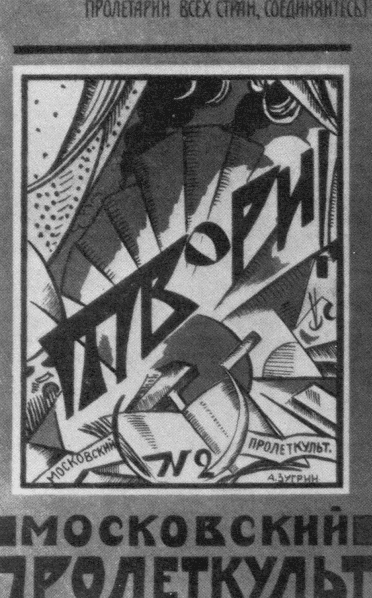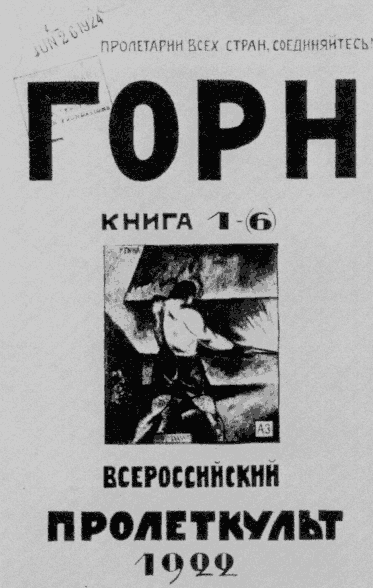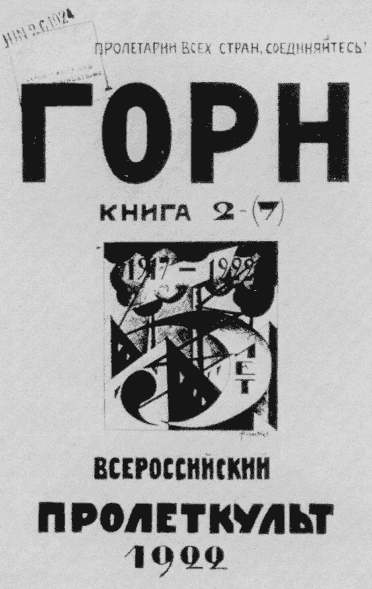[77] Report on the Izhevsk Proletkult for 1919–1920, TsGALI f. 1230, op. 1, d. 1221, ll. 1–1 oh., 11 ob.–12; and Proletarskaia kul'tura , no. 17/19 (1920), p. 89.
[78] Questionnaire from the Tomna Proletkult, 1920, TsGALI f. 1230, op. 1, d. 117, 1.34.
― 119 ―
that he did not say anything at all in response. "Why? Because I really never had worked in a factory and did not have the merits that my Proletkult comrades had."[79]
He was bitter, however, when Lebedev-Polianskii visited the Petrograd organization and chided participants there for giving intellectuals undue influence. The national president singled out Shcheglov for criticism and told him that he should emulate the proletarian methods of the head theater director, Mgebrov. Shcheglov noted with sarcasm that both of these representatives of the workers' interests, Lebedev-Polianskii and Mgebrov, were in fact intellectuals.[80] This struggle was over aesthetics but was couched in the language of workers' control.
This incident once again reveals the malleability of the Proletkult's class-based language. When Shcheglov opposed the aesthetic direction of the Petrograd organization, he was singled out as a suspect intellectual. But the social origins of intellectual friends went unnoticed. Just as participants altered the definition of "worker" to fit the organization's heterogeneous membership, they stretched the meanings of "intellectual" and "specialist" to suit their needs. They even devised new categories for those who had earned their trust and sympathy.
One can see this quite clearly in the answers to a 1921 central questionnaire that asked local leaders to determine whether "specialists" or "Proletkultists" were in charge of artistic studios. This questionnaire would have been an easy way to distinguish between intellectual and worker leaders, but that is not how the participants applied the categories. Instead, they were perfectly willing to give intellectuals the title of Proletkultist. The organization in Belev, for example, reported that its art studio was led by a Proletkultist when the intellectual Timofei Katurkin was in charge.[81] This flexible
[79] D. Shcheglov, "U istokov," in U istokov: Sbornik , ed. I. P. Skachkov (Moscow, 1960), p. 70.
[80] Ibid., p. 75.
[81] Local questionnaire, TsGALI f. 1230, op. 1, d. 118, l. 7 ob.; and a local report on studio work, d. 1581, ll. 28–28 ob., cited in V. V. Gorbunov, "Oktiabr' i nachalo kul'turnoi revoliutsii na mestakh," in Velikii Oktiabr ', ed. Iu. A. Poliakov (Moscow, 1978), pp. 71–72.
― 120 ―
use of social labels was a creative solution to a difficult problem: a simple way for participants to acknowledge the intellectuals' contributions without relinquishing proletarian control was to rename the nonworkers as part of the movement.
The Proletkult was not an organization in which intellectuals led and workers followed. Instead it was an elaborate system of mixed management. Its advocates pointed to the movement's real successes, to the national leaders who came from the proletariat, and to the strong worker presence on its local governing boards. The central Proletkult forcefully argued that it kept much tighter control over experts than did any other Soviet institution.[82] But critics found ample evidence to the contrary. The obvious discrepancy between the Proletkult's claims to proletarian hegemony and its much more modest accomplishments made it highly vulnerable to charges of hypocrisy. It also graphically illustrated how difficult it was to promote cultural creation without granting considerable power to the bearers of cultural expertise.
Defining equitable relations between workers and intellectuals was one of the oldest and most persistent problems of the Russian socialist movement, a problem that began with the inception of socialism and continued well into the Soviet period. Proletkultists were keenly aware of these tensions and devised a number of rules and regulations to minimize them. However, their solutions were clearly inadequate. The obstacles, which previous generations had also faced, remained the same. The lower classes had to be educated to assume positions of power, but who would restrict the influence of the educators?
Certainly the Proletkult never gave up its commitment to
[82] "Neobkhodimoe ob "iasnenie," TsGALI f. 1230, op. 1, d. 51, l. 6.
― 121 ―
workers' control. Class exclusivity defined the organization and justified its existence in the Soviet state. At the same time, however, these principles were artfully suspended to integrate intellectuals sympathetic to the organization's goals. There were definite advantages to this arrangement; participants gained skills they never could have achieved without the aid of skilled cultural workers.
Still, the integration of the old intelligentsia raised serious and debilitating problems for the movement. It undermined the Proletkult's demand for institutional autonomy because the justification for independence was to protect its class identity. It also raised fundamental questions about what proletarian culture should or could be—something given to workers from above or something made by workers from below. At the very least, the large-scale involvement of artists and intellectuals ensured that the culture of the future would bear the marks of those who had been trained in the prerevolutionary past.

1.
Aleksandr Bogdanov, whose writings
on proletarian culture inspired the
Proletkult movement.
Source: Pod znamenem marksizma ,
no. 4 (1928).

2.
Valerian Pletnev, playwright and
Proletkult president from December
1920 until August 1932.
Source: Pechat' i revoliutsiia ,
no. 7 (1927).

3.
The presidium of the national Proletkult organization elected at the
first national conference, September 1918. Sitting from left to right:
Fedor Kalinin, Vladimir Faidysh, Pavel Lebedev-Polianskii, Aleksei
Samobytnik-Mashirov, I. I. Nikitin, Vasilii Ignatov. Standing from
left to right: Stefan Krivtsov, Karl Ozol-Prednek, Anna Dodonova,
N. M. Vasilevskii, Vladimir Kirillov.
Source: Protokoly pervoi Vserossiiskoi konferentsii proletarskikh
kul'turno-prosvetitel'nykh organizatsii, 15–20 sentiabria, 1918 g .,
ed. P. I. Lebedev-Polianskii (Moscow, 1918).

4.
Delegates to the first national Proletkult conference sitting under a
banner that reads "Long Live the International Proletkult."
Source: Protokoly pervoi Vserossiiskoi konferentsii proletarskikh
kul'turno-prosvetitel'nykh organizatsii, 15–20 sentiabria, 1918 g .,
ed. P. I. Lebedev-Polianskii (Moscow, 1918).

5.
Members of the Petrograd Proletkult drama studio performing a
collective reading of Walt Whitman's poem "Europe."
Source: Plamia , no. 21 (1918).

6.
A choral class in the Petrograd Proletkult.
Source: Plamia , no. 9 (1918).

7.
A scene from Valerian Pletnev's play Lena, which is about the strike
that led to the Lena Massacre. The play is being staged by the First
Workers' Theater in Moscow.
Source: Huntly Carter, The New Theatre and Cinema of Soviet
Russia (London, 1924).

8.
A scene from Ostrovsky's play Enough Simplicity for Every Wise Man .
The play was radically revised by Sergei Eisenstein and Sergei Tretiakov
for the First Workers' Theater. The poster reads: "Religion is the
Opiate of the People."
Source: Huntly Carter, The New Theatre and Cinema of Soviet
Russia (London, 1924).

9.
A draft of a panel by the artist Ia. M. Guminer to decorate the Smolnyi
Institute in Petrograd for the first anniversary of the revolution.
The caption reads: "Proletkult—Proletarian Creation Guarantees
the World Commune."
Source: I. M. Bibikova and N. I. Levchenko, Agitatsionnomassovoe
iskusstvo: Oformlenie prazdnestv (Moscow, 1984), vol. 2.

10.
A sketch of a banner for the Moscow Province Textile Workers'
Union designed by members of the Moscow Proletkult art studios.
An example of production art, the banner was to be made from
materials characteristic of the textile trade and to have moving parts
that evoked the workings of spinning machines.
Source: Gorn , no. 7 (1922).

11.
A cover for the Moscow Proletkult journal Create! (Tvori! ) by the
proletarian artist Aleksandr Zugrin. The top caption reads "Proletarians
of all lands, unite!"
Source: Tvori! , no. 2 (1921).

12.
A cover for the Moscow Proletkult journal Furnace (Gorn ) by the
proletarian artist Aleksandr Zugrin. The drawing, "At the Furnace,"
shows a blacksmith at his anvil, a very common image in Proletkult art.
Source: Gorn , no. 6 (1922).

13.
An illustration from the cover of the Moscow Proletkult journal
Furnace (Gorn ) commemorating the fifth anniversary of the Proletkult.
Source: Gorn , no. 7 (1922).
― 122 ―








